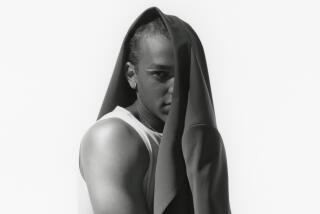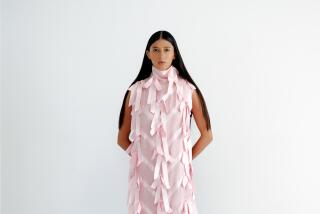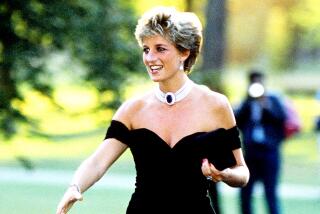Fashion 86 : Something Old and Something New: The Grand-Scale Wedding
Bellville Sassoon’s $3,000 ball gown--with its peplum waist and stunning bustle back--is one of the newest London designs to roll off the Vogue Patterns press. But the firm doesn’t envision it just as a party gown; they also offer it as a wedding gown.
“It’s an indication of what’s happening,” claims Herman Phynes, promotion director for Vogue and Butterick patterns. “Women are looking beyond wedding fashion for their gowns.”
They are also looking beyond simple celebrations, and despite the national average tab of $10,000, elaborate formal weddings are the rage.
In the words of Jim Helm, who designs $1,000-and-up couture for the Galina bridal firm: “Marriage has become grand again.”
For many, it becomes grandest in the fall and winter when bridesmaids often march down the aisle in jewel-tone velvets, and brides frequently choose weighty silk-faced satins or heavy laces.
In a mood for high-fashion finery rather than froufrou, today’s sophisticated winter bride prefers a slimmer gown (often as slim as a sheath), reminiscent of the ‘20s, embellished with embroidery, shirring, a peplum, a bustle, all-over sequins or bugle beading.
For that reason, Sarah Ferguson, unlike her famous sister-in-law, won’t be the highly copied bride.
According to Barbara Tober, editor-in-chief of Bride’s magazine, “Her gown won’t be a trend-setter the way Princess Diana’s was, because that was 1981, and people were looking for different things. Today we seem to be moving closer to the body in bridal. But we’ll certainly remember the sentimental gesture of having her husband’s first initial embroidered on the train.”
Sentimental gestures are cropping up outside Westminster Abbey too. Caroline Kennedy exchanged vows recently in a shamrock-strewn bridal gown that paid homage to her Irish heritage.
Also, Helm says one of his Bullocks Wilshire customers “has made her theme hearts. Her engagement ring was designed in a heart shape, her shoes have lace motifs with hearts, and the dress already had hearts on it.”
Katrina Anast, another Helm’s client, says she chose October for her wedding “because I didn’t want to get married when it was hot. I wanted to be cool, calm and collected. And I’ve always wanted a winter wedding so that I could wear a more formal fabric and have my bridesmaids in darker colors of velvet.”
The 25-year-old quality-assurance engineer, who has been thinking about her wedding since she was “8 or 9,” will marry in a cathedral with eight bridesmaids in attendance.
While six to eight bridesmaids aren’t unusual these days, the number Rochelle Mellon plans for her second marriage in November could take the cake.
“The first time, I didn’t have a big wedding or a white gown,” explains 45-year-old Mellon, who is a driver for several movie studios.
Always a bridesmaid in college, she ended up with “27 dresses made out of horrible taffeta.” Determined to have a fun wedding rather than a conventional one, Mellon plans to put a bridesmaid in each of her leftovers and add paper overlays--to match her own paper gown.
Once the reception is over, Mellon will snip off the huge bottom ruffle, ask guests to sign it and leave for her honeymoon wearing the short version of the dress.
Made of tough interfacing, the $140 gown is the invention of Susan Lane, whose real forte is antique-looking lace dresses.
Operating out of her Country Elegance boutique in North Hollywood, Lane has designed bridal gowns for the screen (“General Hospital,” “Love Boat,” “Dynasty”) and for the recent nuptials of Cristina Ferrare and Lesley Ann Warren.
Her customers “tend to be career women. We don’t get the woman who comes in with her mother as much as the woman who comes in alone, who knows what she wants and can make decisions.”
The decision these days is often “a tight silhouette,” Lane claims. “Like the old Mae West style. It’s fitted past the knees then flares out. You never saw women wearing anything like that a few years ago. It’s a slinky look but it can be very appropriate with beading and lace.”
Hats with veils are out, Lane says, but veils themselves are in and sometimes for a special reason: “If a woman wants the look of a very formal wedding but falls in love with a dress without a train, she can wear a cathedral veil. It will give her that look.”
Designer Diana Venegas, whose Sunset Boulevard boutique also caters to celebrity brides, finds that weddings have become “more formal, more lacy, more elegant.”
In the avant-garde of the seductive look for the altar, Venegas stopped lining dresses years ago to make them “more romantic and sexy.” Convinced a bride should dress to please herself, she once designed a black chiffon wedding gown and decorated it with tiny red roses that reappeared on the black lace headpiece.
The bride had “white, white skin, jet-black hair and blue, blue eyes,” the designer says. “She just didn’t look good in any of the ivories, whites or pastels, and she wanted to look her best. Her mother was very upset. But she did it and she looked great and that’s what’s important.”
Not every woman who wants a custom-made gown can afford the average $1,800 Venegas price tag. But there are other ways, Butterick’s Herman Phynes suggests.
The Bellville Sasson gown could be made for a fraction of the original $3,000 cost (seven yards of silk taffeta at about $20 a yard, $15 for the pattern, $350 dressmaker’s fees, plus $20 for netting and notions.) “You turn it into a one-of-a-kind by making the decisions: the shade of white you like, the embellishments you want. You become part designer of your wedding gown,” Phynes says.
And with a little bit of extra yardage, “A bride can do something close and warm for her groom. She can make his waistcoat or cummerbund and tie. Then he will be wedded to her in color and fabric.”






